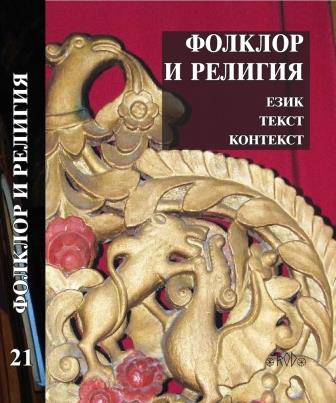ВИЗУАЛИЗАЦИИ НА ФОЛКЛОРНИ ТЕКСТОВЕ В ТВОРЧЕСТВОТО НА НИКОЛА КОЖУХАРОВ (1892–1971) В КОНТЕКСТА НА БЪЛГАРСКОТО ИЗКУСТВО ОТ 20-ТЕ ГОДИНИ НА ХХ В.
VISUALIZATIONS OF FOLKLORE TEXTS IN THE WORKS OF NIKOLA KOZHUHAROV (1892–1971) IN THE CONTEXT OF BULGARIAN ART FROM THE 1920’s
Author(s): Daniela PetrovaSubject(s): Anthropology, Social Sciences, Fine Arts / Performing Arts, Visual Arts, Sociology, Cultural Anthropology / Ethnology, Culture and social structure , Sociology of Art, History of Art
Published by: Асоциация за антропология, етнология и фолклористика ОНГЬЛ
Keywords: Art; Art History; History; Bulgarian art; Folklore; Modern art; Native art; Modernism; Symbolism;
Summary/Abstract: After the end of the World War I, Bulgarian artists turned their attention to the folklore tradition and the Orthodox faith in order to culminate in a process that began about ten years earlier by authors such as Haralampi Tachev and Stefan Badzhov. At the forefront is the search for the native and its contemporary reading. This long journey in Bulgarian fine art began with the late Art Nouveau aesthetics and the rediscovery of medieval Bulgarian ornamentation from frescoes or handwritten illuminations and reached its most significant moment in the Bulgarian artist’s view of the folklore text, tradition, folk faith. The newly established in 1919 society “Rodno izkustvo (native art)” provides a haven for many different creative personalities, but all united 147 by the main motive for the search for the “native”. The main figure in the “Rodno izkustvo” movement is Nikola Kozhuharov (1892–1971), who soon returned from studying in Paris, taking an active part in the artistic life in Bulgaria. His early work is related to the aesthetics of symbolism – very late, but popular among Bulgarian artists. Gradually, Kozhuharov’s experiments with the universal symbolist narrative took on a characteristically Bulgarian appearance. The nymphs in his paintings turn into samodivi and zmeitsi, the women, unnamed by nationality and universal in aesthetic characteristics, wear Bulgarian folk costumes. Among his plots, there are titles such as: “Samodiva rides a grey deer”, “Zmeyove and zmeitsi are stealing Radka”, “Sun steals a beautiful Grozdanka” etc. The choice of titles for the author is not accidental. Upon closer examination, behind these names the outlines of specific folklore texts are clearly visible. Such a study of the text and its close connection with the pictorial image is most clearly observed in the work of Kozhuharov, which clearly speaks of his interest in folklore and the derivation of the image with the characteristics of the “native”. The modern of its time reading of the authentic Bulgarian folklore, although a topic of many art studies, poorly concretizes the role of the text, which is the basis for the creation of a visual image. In my article, I will try to textually read Kozhuharov’s paintings based on the texts of folk songs and legends, I will compare the characteristics of the textual and visual image and I will try to find the border between the creative imagination and the concreteness of the word.
Journal: Годишник на Асоциация за антропология, етнология и фолклористика »Онгъл«
- Issue Year: 2022
- Issue No: 21
- Page Range: 136-147
- Page Count: 12
- Language: Bulgarian
- Content File-PDF

